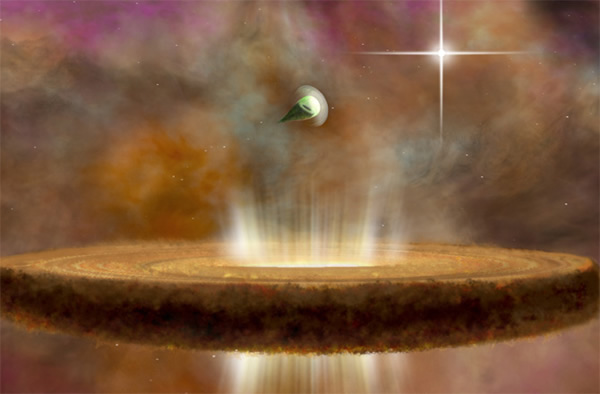Orion's 'Death Stars' Exterminate Baby Planets
Image: Top: This artist’s concept shows two proplyds, or protostars, around a massive O-type star.
If you’re in the Northern Hemisphere, you are getting quite a lovely show in the evening with the constellation of Orion overhead. But in it lurks a true-planet killer… or several.
The cycles of life and death of stars are closely intertwined, especially in massive star-forming regions like the Orion Nebula. So it’s actually not that much of a surprise that the birth and life of one object can lead to the end of another. Astronomers used the Atacama Large Millimeter/Submillimeter Array in Chile to see these interactions take place.
The Hubble Space Telescope famously imaged the Orion Nebula’s “proplyds” or tear-drop shaped protostars with cocoons and disk of dust and gas still surrounding them. They are lit up and being swept back by the stellar winds of some of the larger, older stars in the nebula.
ALMA, with its sensitivity to seeing warm objects hidden in dusty regions, imaged the proplyds found by Hubble and found many more than the optical telescope could see. The astronomers could also measure the mass of these proto-planetary systems. However, it turns out that many are doomed.
The Orion Nebula is lit up by true stellar monsters; O-type stars that are tens of times the mass of our sun with surface temperatures up to 50,000 K. These massive stars power the nebula and, when they explode as supernovae, have the capacity to shut down star formation or jump-start it in a new region.
In this case, the O-stars are destroying the proplyds that form too close, stripping them of the gas and dust that otherwise would have formed planets. In just a few million years, the proplyds within one light-year of an O-star are stripped bare.
This has consequences for the number of planets that can exist in our Galaxy. Many stars, including our sun, probably formed in a massive star-forming region like the Orion Nebula. How many potential solar systems were destroyed before they even had a chance to start? Surely, some were far enough away from any O-star to survive, as evidenced by the thousands of exoplanets that we’ve found already, not to mention our own existence.(Mar 13, 2014 11:04 AM ET // by Nicole Gugliucci)












